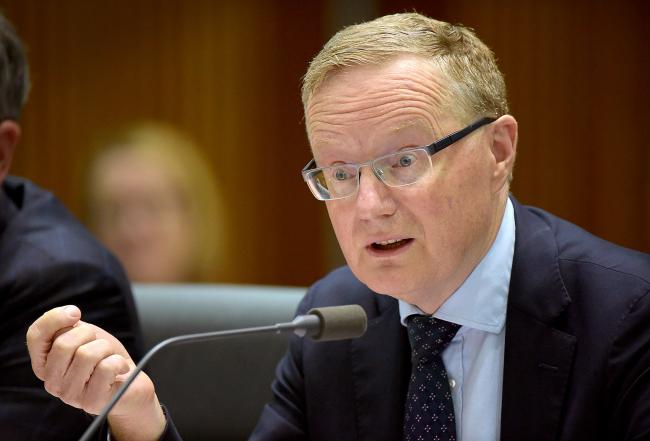(Bloomberg) -- Reserve Bank Governor Philip Lowe said he’s still prepared to reduce Australia’s record-low interest rates further if needed, though signaled the economy could be through the worst of its slowdown.
The central bank’s own estimates, released as Lowe spoke, pushed back expectations for faster economic growth and inflation and a lower unemployment rate. Importantly, these were based on current market pricing for two more RBA cuts that would bring the cash rate to 0.5%. Nonetheless, the RBA chief struck a note of quiet optimism.
“There are signs the economy may have reached a gentle turning point,” Lowe said in his opening statement to a parliamentary panel in Canberra Friday. “Consistent with this, we are expecting the quarterly GDP growth outcomes to strengthen gradually after a run of disappointing numbers.”
The RBA undertook back-to-back rate cuts in June and July to a record-low 1% as it sought to revive a decelerating expansion and drive down unemployment. It joined developed-world counterparts in easing as the U.S.-China economic confrontation deepens, damping global confidence and investment.
“While we might wish it were otherwise, it is difficult to escape the fact that if global interest rates are low, they are going to be low here in Australia too,” Lowe said in his semi-annual testimony. “Our floating exchange rate gives us the ability to set our own interest rates from a cyclical perspective, but it does not insulate us from long-lasting shifts in global interest rates driven by saving/investment decisions around the world.”
The Aussie dollar has declined almost 8% in the past 12 months as the economy slowed and money markets boosted bets the RBA would resume easing. The currency climbed Friday morning in Sydney as markets read into the remarks that the governor was gaining confidence that growth could be turning up.
Lowe said it was prudent to be thinking about unconventional policies, though he reiterated that he believed this was unlikely in Australia.
The key forecast revisions in the Statement on Monetary Policy were as follows:
- Core inflation will be around 1.75% next year and reach the bottom of the RBA’s 2-3% target by June 2021, a year later than projected in May
- Unemployment will be around 5.25% through 2020 and fall to 5% by June 2021, two years later than projected in May
- GDP growth will be slightly lower this year, at 2.5% versus previous estimate of 2.75%
Lowe’s gentle optimism expressed in his testimony is based on the RBA’s lower rates, recent tax cuts, a lower currency, a brighter outlook for investment in the resources sector, some stabilization of the housing market and ongoing investment in infrastructure.
“It is reasonable to expect that, together, these factors will see growth in the Australian economy return to around its trend rate next year,” he said. Still, even an improving outlook won’t resolve the economy’s underlying challenges.
“In the central scenario that I have sketched today, inflation will be below the target band for some time to come and the unemployment rate will remain above the level we estimate to be consistent with full employment,” Lowe said. “While this remains the case, the possibility of lower interest rates will remain on the table.”
The governor also highlighted the elephant in the room: the political and economic uncertainty worldwide.
“These disputes pose a significant risk to the global economy,” Lowe said. “Not only are they disrupting trade flows, but they are also generating considerable uncertainty for many businesses around the world. Worryingly, this uncertainty is leading to investment plans being postponed or reconsidered.”
The RBA chief was pressed several times on the potential for unconventional policy. The cash rate is just 1%, a similar level to the Federal Reserve’s when it undertook QE, and New Zealand’s governor said this week it was possible he would have to consider alternative measures after cutting his rate to 1%.
Lowe acknowledged that it was possible that the RBA would end up at the zero lower bound and spelled out the measures taken by international counterparts and some of his thoughts on their efficacy. He also provided a snapshot of his thinking about them for Australia.
“I think the focus would be on trying to reduce the risk-free interest rate,” Lowe said. “If we reduced the cash rate down to a very low level, it’s possible as circumstances warranted that we could take action to lower the risk-free rates further out along the term spectrum.”
(Updates with release of latest quarterly forecasts from second paragraph.)
